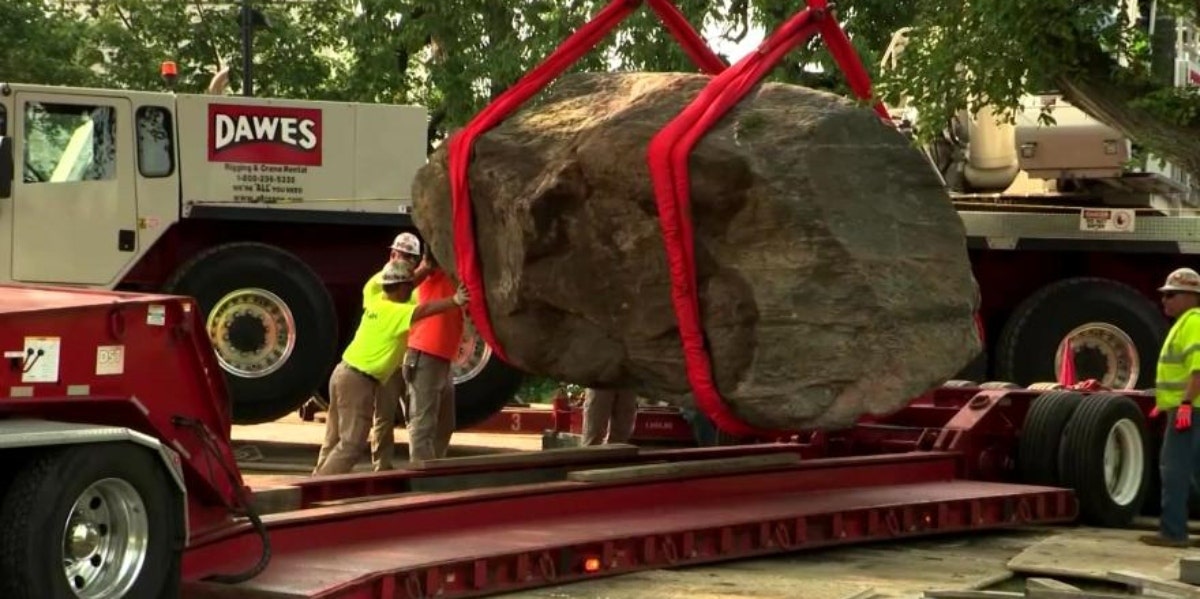University Of Wisconsin Uses $50k Donation To Remove 2 Billion-Year-Old Rock Students Call 'Painful Symbol' Of Racism
The school's Black Student Union wanted Chamberlin Rock gone for over a year.
 YouTube
YouTube The University of Wisconsin-Madison has removed a more than 2 billion-year-old boulder from its campus after students of color issued complaints about its racist associations.
The boulder formerly known as Chamberlin Rock had sat on the college campus since 1925, but, amid a growing anti-racist movement last summer, the Wisconsin Black Student Union, in partnership with the Native American student organization Wunk Sheek, labeled the artifact a symbol of racism and called for its removal.
What is Chamberlin Rock — and why did the University of Wisconsin remove it?
The "rock" is a pre-Cambrian era glacial erratic that had been brought to the top of Observatory Hill on the UW-Madison campus in 1925 as an ode to Thomas Chamberlin, a noted geologist who also served as president of the college from 1887 to 1892.
However, the rock also bears an association to racist and derogatory terminology that has been a lasting reminder of discrimination for students of color.
Chamberlin Rock was referred to by a racist slur in a 1925 newspaper headline.
In 1925, an article in the Wisconsin State Journal referred to the rock by a deeply offensive nickname that included a racist slur.
The slur, a commonly used name for large dark rocks at the time, was used in a headline that read "Dig Up Huge 'N-head."
Though historians have found no evidence the term was otherwise associated with the boulder or used by anyone on campus, it was noted that "the Ku Klux Klan was a pervasive presence in the Madison area in the early part of the last century and that people of color were often mocked in minstrel shows at campus facilities and in campus satiric periodicals."
Calls by the Black Student Union demanding its removal were echoed by Native American student organization Wunk Sheek. UW–Madison’s main campus is on ancestral Ho-Chunk land.
“It was very meaningful for me to be there and to see the process all the way through to the end,” said Nalah McWhorter, a student who served as president of the Wisconsin Black Student Union during the 2020-21 academic year.
“I see this as offering the next generation of students something to build off of.”
The Black Student Union shared a statement on Instagram about the removal of the boulder.
In the caption they wrote, "Today history was made! We are filled with joy to finally announce the removal of Chamberlin Rock off of UW-Madisons campus. After a year of hard work, we can now say we accomplished 1 of our 4 demands. This is a great accomplishment that we hope all students can celebrate & feel proud of. Thank you to everyone who had a hand in this accomplishment & supported us along the way!"
Chamberlin Rock has been relocated to university-owned land nearby.
Removal of the 42-ton boulder took hours and is said to have cost approximately $50,000. The price of removal will be paid by the chancellor's office using private donations.
As the rock still holds educational significance, it has been relocated to university-owned land southeast of Madison near Lake Kegonsa — an area within a glacial till landscape about 17 miles from the UW-Madison campus.
The plaque honoring Chamberlin was removed from the rock and a new plaque in his honor will be placed on Chamberlin Hall.
University of Wisconsin-Madison is working on anti-racism initiatives.
Removal of the rock in and of itself may seem like a small step towards building a truly anti-racist campus, but it is considered part of a larger college-wide movement.
In January, University of Wisconsin–Madison’s “Humanities Education for Anti-racism Literacy (HEAL) in the Sciences and Medicine” program was one of 16 projects to receive funding from the Andrew W. Mellon Foundation’s $5 million fund for anti-racist education.
The removal of the Chamberlin Rock is also part of a country-wide movement to strip back statues, monuments and historical sites that embody a history of racism.
For Black students on the campus, “the rock symbolized the history of prejudice and racism that has taken place on this campus.”
It’s removal is meant to offer hope that the influence of this painful history will disappear too.
Alice Kelly is a senior news and entertainment editor for YourTango. Based out of Brooklyn, New York, her work covers all things social justice, pop culture, and human interest. Keep up with her Twitter for more.

